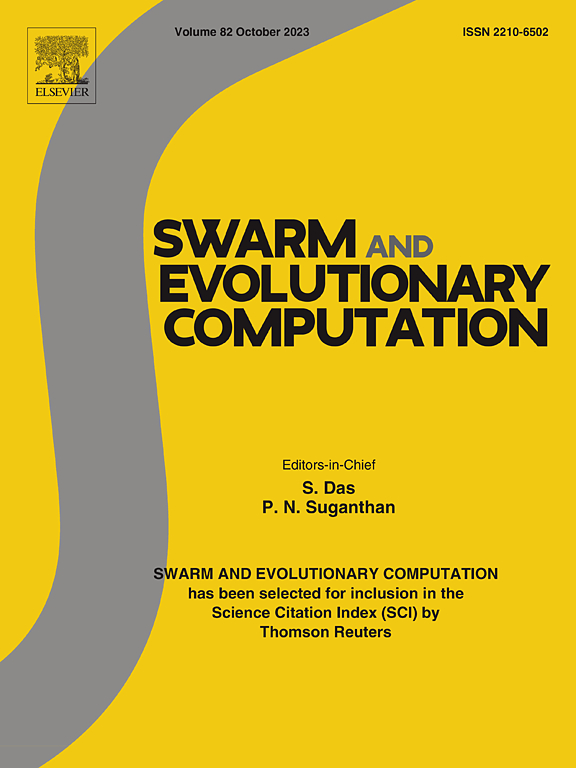基于群空间跳变算法的有限元双层上下文信息神经网络最优特征选择与检测
IF 8.2
1区 计算机科学
Q1 COMPUTER SCIENCE, ARTIFICIAL INTELLIGENCE
引用次数: 0
摘要
本研究提出了一种基于脑电图(EEG)的癫痫发作检测(ESD)的新方法,该方法使用结合群空间跳变算法(SSHA)的有限元双级上下文信息神经网络(AFi-EDLCINNet)。该方法解决了当前ESD方法中上下文敏感性和计算效率方面的挑战。来自波士顿-麻省理工学院儿童医院(CHB-MIT)和波恩数据集的原始EEG信号采用加权引导图像滤波和熵评价加权(WGIF-EEW)进行预处理,以消除噪声并确保信号清晰度。使用多离散小波变换(MDWT)进行特征提取以捕获关键模式。采用白鲨优化算法和棕熊优化算法(WSO-BBOA)相结合的混合优化方法进行特征的优化选择,确保只选择最重要的特征。将选择的特征输入到AFi-EDLCINNet中进行分类,通过SSHA进一步优化,提高癫痫发作检测的准确性和效率。该方法实现了99.9%的分类准确率和0.7%的低错误率,优于其他方法。该框架为早期癫痫发作检测提供了可靠、稳健的解决方案,为临床医生提供了个性化治疗计划的有力工具。该解决方案使用Python实现,展示了其在实际应用程序中的实用性和灵活性。本文章由计算机程序翻译,如有差异,请以英文原文为准。
A finite-element dual-level contextual informed neural network with swarm space hopping algorithm based optimal feature selection and detection for EEG-based epileptic seizure detection
This study proposes a novel approach for Electroencephalogram (EEG) based Epileptic Seizure Detection (ESD) using a Finite-Element Dual-Level Contextual Informed Neural Network (AFi-EDLCINNet) integrated with the Swarm Space Hopping Algorithm (SSHA). The approach addresses the challenges of contextual sensitivity and computational efficiency in current ESD methods. Raw EEG signals from the Children's Hospital Boston-Massachusetts Institute of Technology (CHB-MIT) and Bonn datasets are preprocessed with Weighted Guided Image Filtering and Entropy Evaluation Weighting (WGIF-EEW) to eliminate noise and ensure signal clarity. Feature extraction is performed using Multi-Discrete Wavelet Transform (MDWT) to capture critical patterns. A hybrid optimization method combining the White Shark Optimizer and Brown Bear Optimization Algorithm (WSO-BBOA) is used for optimal feature selection, making certain that just the most important features are included are selected. The selected features are input into AFi-EDLCINNet for classification, which is further optimized by SSHA to improve accuracy and efficiency in detecting epileptic seizures. The proposed method achieves an impressive 99.9 % classification accuracy and a low error rate of 0.7 %, outperforming other methods. This framework offers a reliable, robust solution for early seizure detection, providing clinicians with a powerful tool for personalized treatment planning. The solution is implemented using Python, demonstrating its practicality and flexibility for real-world applications.
求助全文
通过发布文献求助,成功后即可免费获取论文全文。
去求助
来源期刊

Swarm and Evolutionary Computation
COMPUTER SCIENCE, ARTIFICIAL INTELLIGENCEC-COMPUTER SCIENCE, THEORY & METHODS
CiteScore
16.00
自引率
12.00%
发文量
169
期刊介绍:
Swarm and Evolutionary Computation is a pioneering peer-reviewed journal focused on the latest research and advancements in nature-inspired intelligent computation using swarm and evolutionary algorithms. It covers theoretical, experimental, and practical aspects of these paradigms and their hybrids, promoting interdisciplinary research. The journal prioritizes the publication of high-quality, original articles that push the boundaries of evolutionary computation and swarm intelligence. Additionally, it welcomes survey papers on current topics and novel applications. Topics of interest include but are not limited to: Genetic Algorithms, and Genetic Programming, Evolution Strategies, and Evolutionary Programming, Differential Evolution, Artificial Immune Systems, Particle Swarms, Ant Colony, Bacterial Foraging, Artificial Bees, Fireflies Algorithm, Harmony Search, Artificial Life, Digital Organisms, Estimation of Distribution Algorithms, Stochastic Diffusion Search, Quantum Computing, Nano Computing, Membrane Computing, Human-centric Computing, Hybridization of Algorithms, Memetic Computing, Autonomic Computing, Self-organizing systems, Combinatorial, Discrete, Binary, Constrained, Multi-objective, Multi-modal, Dynamic, and Large-scale Optimization.
 求助内容:
求助内容: 应助结果提醒方式:
应助结果提醒方式:


